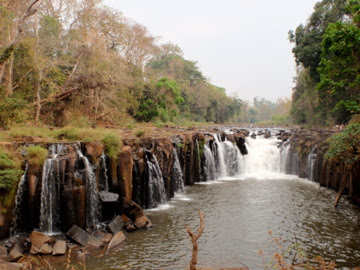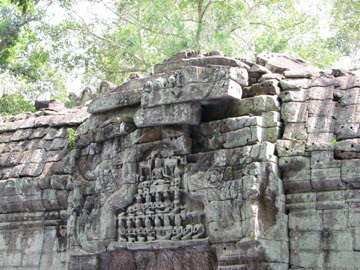We also visited the Central Market (built in 1937) :
One of the most pyschologically difficult places we visited was the Toul Sleng Genocide Museum (aka S21) a former high school used as a prison and place of torture by the Khmer Rouge
Interrogators used the wooden pole (originally used for students' physical education) for torture. Prisoners were hung upside down until they lost consciousness, then their head was dipped into a barrel of filthy water which shocked the victim back into consciousness and the process started again.
Phnom Penh streetfood :
After a few day in Phnom Penh we travelled to the coast, to
Sihanoukville to go diving. Our dive sites were two hours offshore near islands called the Koh Rong.
Leaving Sihanoukville we travelled to
Siem Reap where we started visiting the fabulous temples of Angkor.
 |
| offering to Buddha - note the meat offering |
At the temples were many carving of
apsaras - which are female
devatas (angels).
 |
| seated buddha in front of a naga |
Ta Phrom is famous as the temple that has been left overgrown with trees. Some might recognise it from the film
Tomb Raider.
The
Bayon Temple has fifty towers sculpted with four-faced
Bodhisattva Avalokiteshvara. A
bodhisattva is an enlightened being, and
Avalokiteshvara is one who embodies the compassion of all Buddhas.
 |
| loved the colour contrast here |
 |
| four-faced Bodhisattva Avalokiteshvaras |
These musicians have been maimed by landmines :
A typical Cambodian rural house on stilts :
South gate of Angkor Thom
On our last day in Siem Reap we went to
Tonle Sap lake to see the floating villages.
After leaving Cambodia we travelled to southern
Laos for a few days.
Suggested reading:
Angkor (New Horizons)
by Bruno Dagens. "This book traces the origins of the mysterious ruins and tells the story of their rediscovery through documentary photographs, maps and illustrations".




























































